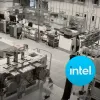Following the assembly, the system will undergo a calibration phase, expected to last several weeks to months. This phase includes the 'lighting up' process, where photons interact with the resist on wafers, a critical step in the lithography process that ASML recently achieved with a similar High-NA EUV tool in Veldhoven, Netherlands.
The ASML High-NA EUV lithography system is designed to achieve an 8nm resolution, a significant improvement over the existing Low-NA EUV scanners, which offer a 13nm resolution in a single exposure. This enhancement allows for the manufacturing of transistors that are approximately 1.7 times smaller, effectively increasing transistor density by nearly threefold. Achieving 8nm critical dimensions is crucial for fabricating chips with sub-3nm process technologies, a goal the industry aims to reach between 2025 and 2026. Intel's primary use of the Twinscan EXE:5000 system will be to gain familiarity with High-NA EUV technology, evaluating its applicability in Intel's 18A process technology. Although not initially intended for high-volume production, Intel plans to incorporate High-NA lithography in its high-volume manufacturing processes, starting with the Intel 14A fabrication process.
ASML has indicated that the next generation of High-NA EUV lithography tools will cost more than twice as much as the current Low-NA EUV systems, with a price tag of approximately $380 million, depending on the configuration. Intel's CEO, Pat Gelsinger, has estimated the cost of the machine at around '400-ish million dollars'. In contrast, the current Low-NA Twinscan NXE EUV systems are priced at around $183 million, with variations based on the model and configuration. ASML has reported receiving "10 to 20" orders for its High-NA EUV systems from major industry players, including Intel, Samsung, SK Hynix, and TSMC.

